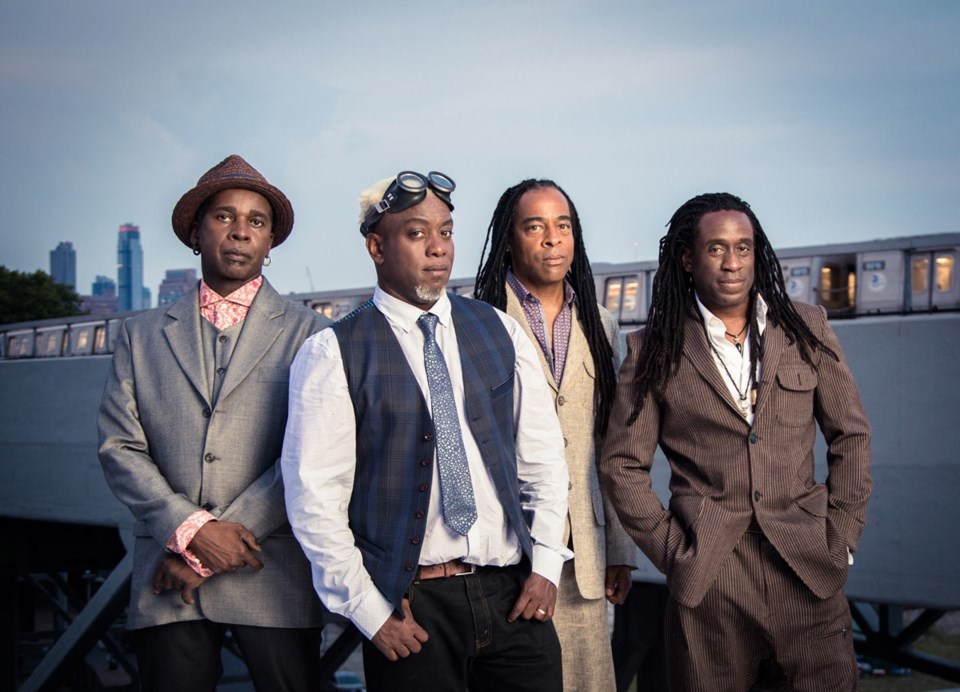What: Aerosmith with Living Colour
When: Thursday, 7:30 p.m.
Where: Save-on-Foods Memorial Centre, 1925 Blanshard St.
Tickets: $199.50, selectyourtickets.com, 250-220-7777, and the Save-on-Foods Memorial Centre box office
Rock ’n’ roll occupies a large chunk of real estate in the mind of guitarist Vernon Reid, but the genre is by no means his only influence.
Blues and funk also play key roles in the musical melange that is Living Colour, along with hardcore punk, free jazz and funk. Living Colour is “the collision of all of that” and more, Reid said this week from Santa Barbara, California, where the group he founded in 1983 was prepping to open for Aerosmith.
“That’s really what it is about, more than a message.”
Living Colour certainly had a message to convey in the late ’80s and early ’90s, when it was considered one of the most vibrant and vital new acts in rock. The group, which also includes singer Corey Glover, drummer Will Calhoun and bassist Doug Wimbish, released its star-making debut, Vivid, in 1988, which kicked off a successful five-year run for the band — one that had deep social and political reverberations at the time.
For starters, Living Colour was a rock band composed of four black men, a groundbreaking collaboration then, as it is now. Secondly, the group rarely shied away from tough topics, such as racism, sexual identity and idol worship — another new angle in rock during the ’80s, for all but the most established acts.
A quick summation of Living Colour and what it stood for a quarter-century ago can be gleaned through the song Elvis Is Dead, a highlight from Living Colour’s 1990 album Time’s Up.
The song — about one of America’s most revered white icons — is nearly four minutes of spastic funk, with oddly erratic cameos from Rolling Stones singer Mick Jagger, James Brown saxophonist Maceo Parker and rock icon Little Richard. The album as a whole was an unpredictable amalgam of influences and messaging, but the concept clearly hit home with audiences.
Time’s Up won Living Colour the second of two consecutive Grammy Awards for best hard rock performance. Living Colour’s first Grammy was given to Cult of Personality, the quartet’s signature song.
Cult of Personality, which features snippets of speeches from Malcolm X, John F. Kennedy, and Franklin D. Roosevelt, is a showcase for Reid’s inventive guitar work, which has been voted some of the best in rock history. His solo on the hit song was named one of the best ever by Guitar World magazine, while Rolling Stone put Reid ahead of Eddie van Halen on its list of the 100 greatest guitarists.
But as with everything concerning Living Colour, very little of what’s on the surface is a true reflection of what lies beneath. Reid is an impressive rock guitarist, indeed, yet he’s proficient at more than power chords, thanks to a pedigree that includes time with several jazz greats and hip-hop acts.
By making the music of Living Colour more appealing to a wider audience, Reid said he’s paying respect to black pioneers who paved the way, from Fishbone and Thin Lizzy’s Phil Lynott to Bad Brains and Prince.
“There’s so many other people who sacrificed a great deal for Living Colour to exist. And that is something I’m very mindful of before I start talking about my role or what we did.”
The band’s current tour with Aerosmith finds Living Colour playing its first arena-scale concerts in some time. For a variety of reasons, mostly to do with solo projects and other out-of-band commitments, Living Colour has been an on-and-off entity for years, with a decade separating studio albums Stain (1993) and Collideøscope (2003).
There is a plan for the band to follow up its last album, 2009’s The Chair in the Doorway, with a recording sometime this year, but tour dates through August are the priority at the moment, Reid said.
Studio recording is when Reid has a chance to get what is inside his head down on tape.
Playing live, however, is when the pure feeling in his gut transfers out into the audience.
“Whatever sized room, large or small, if people are familiar with the music and like the music, or people are open to the music, or are willing to be changed by the experience — that’s really my perfect scenario.”
Whether it’s a tour with Aerosmith or a headlining trek of their own, Reid loves it “when the performance is a conduit for everyone to connect.”
Room size matters not, he admitted.
“That’s what I want in my life, more than numbers of people. Quality not quantity.”
